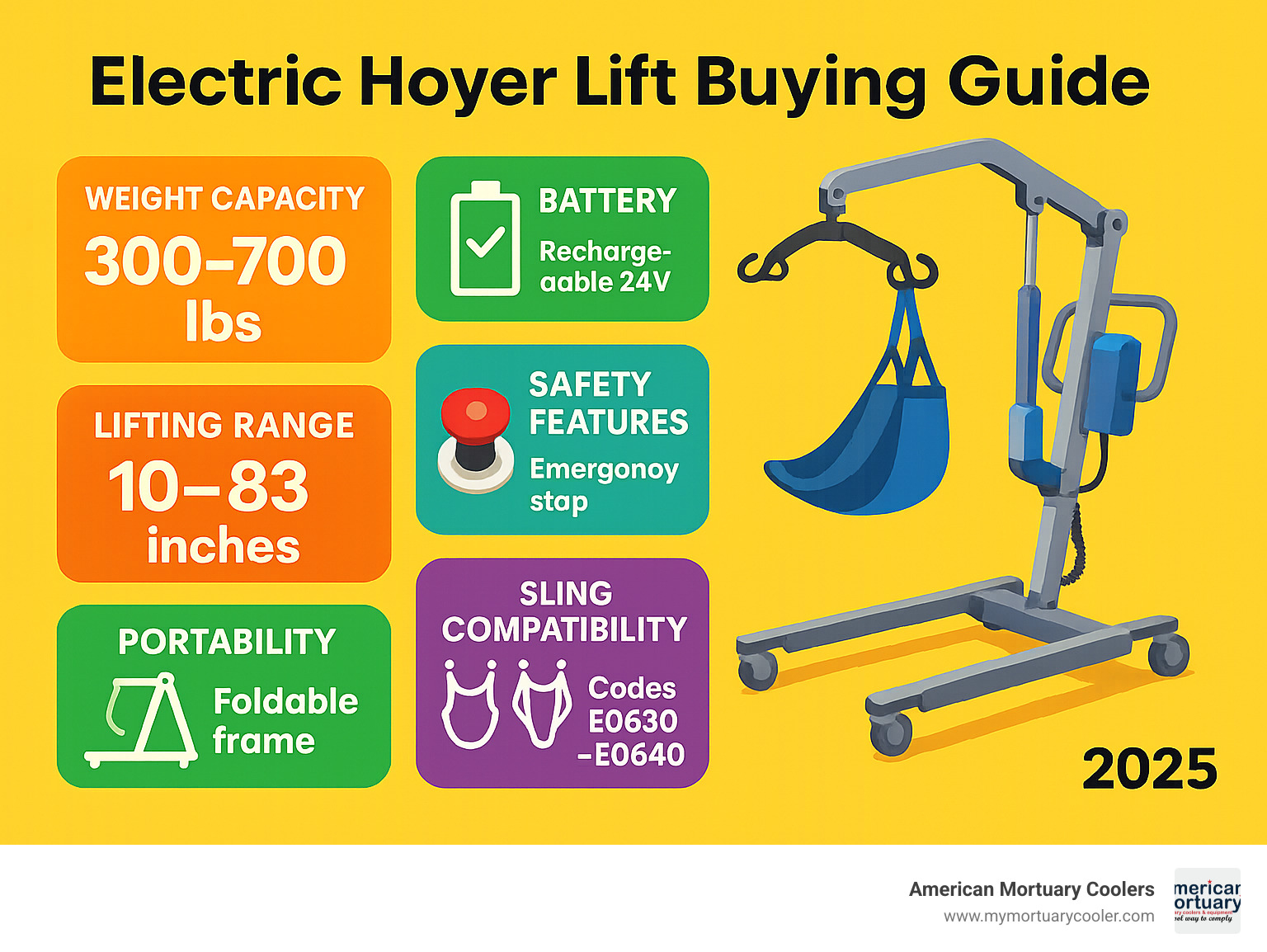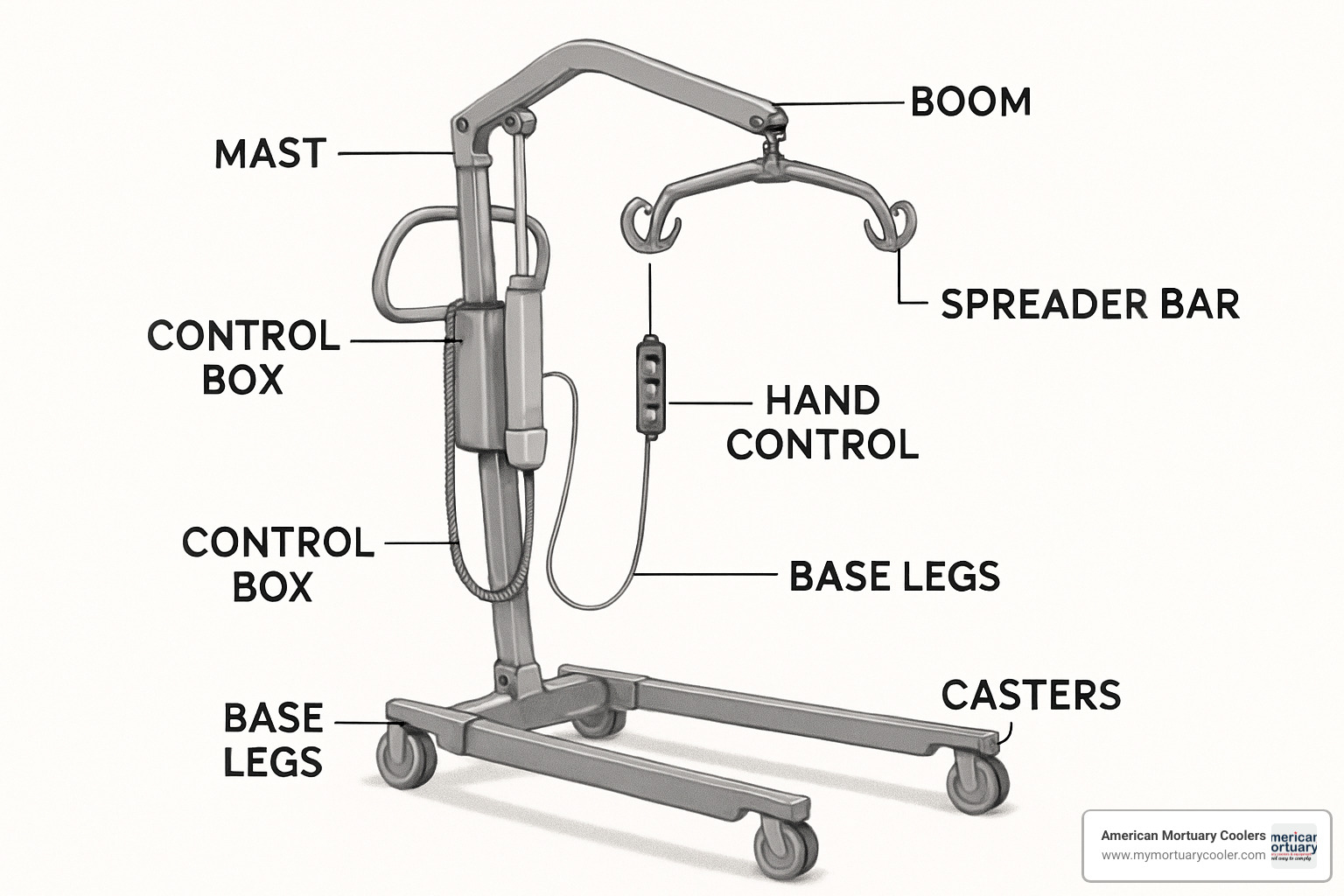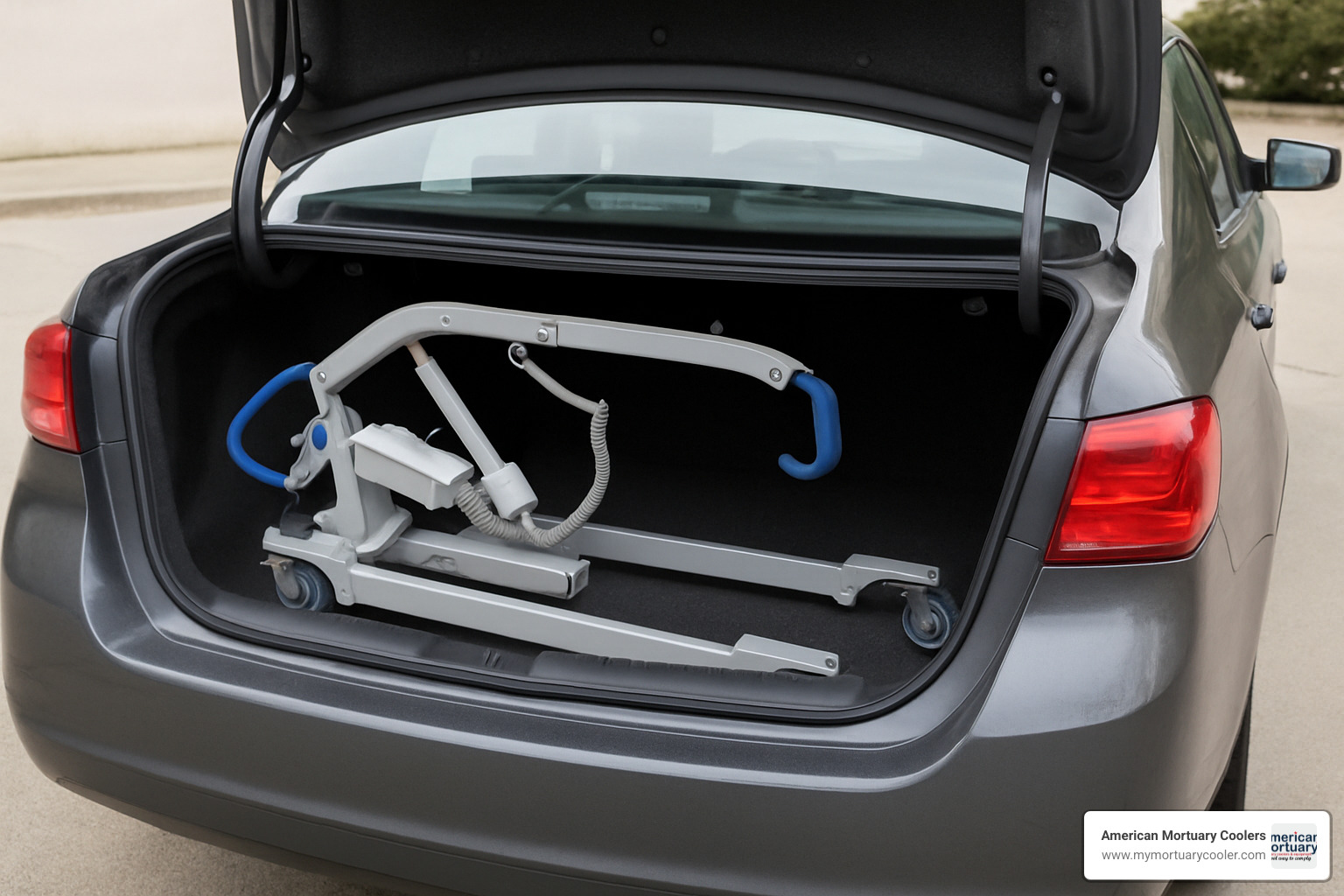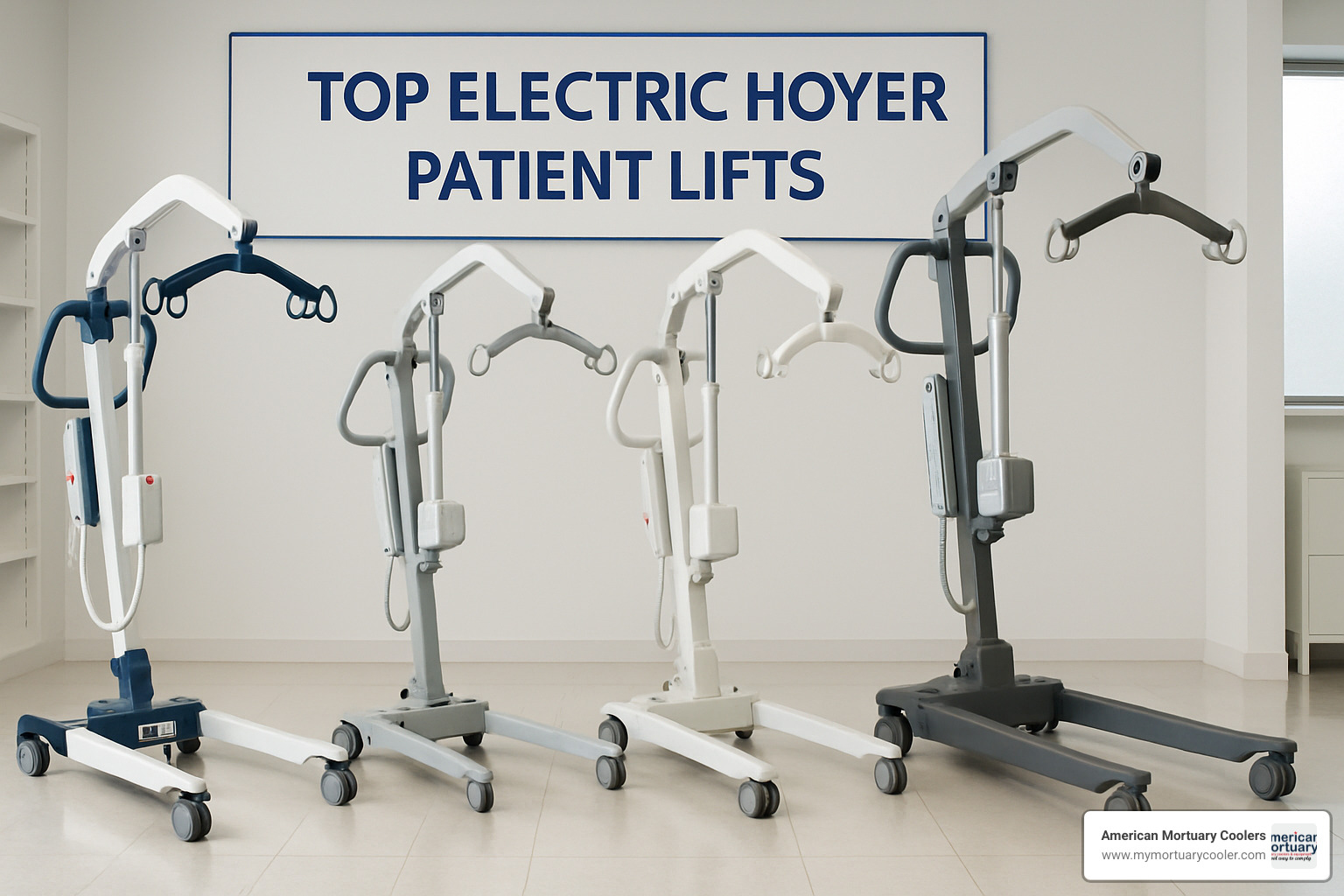Understanding Electric Hoyer Lifts: Your Complete Transfer Solution
An electric hoyer lift is a battery-powered patient transfer device that safely moves individuals with limited mobility between beds, chairs, wheelchairs, and other surfaces. Here's what you need to know:
Key Features:
- Weight capacity: 300-700 lbs depending on model
- Power source: Rechargeable 24V battery systems
- Operation: Push-button hand control for smooth lifting
- Portability: Many models fold without tools for storage
- Safety: Emergency stop buttons and manual lowering backup
Main Benefits:
- Reduces caregiver back strain and injury risk
- Enables single-person transfers
- Provides consistent, steady lifting motion
- Supports floor pick-up capabilities
- Works with various sling types for comfort
Electric hoyer lifts serve hospitals, nursing homes, and private residences where safe patient transfers happen multiple times daily. Battery-powered operation eliminates the manual pumping required with hydraulic models, making transfers smoother and less physically demanding for caregivers.
As one community member shared: "An 86-year-old woman using an electric Hoyer to lift her post-polio husband off the floor" - showing how these devices enable care even when caregivers have physical limitations.
Whether you're comparing manual versus electric models, evaluating weight capacities, or understanding insurance coverage through Medicare codes like E0630, this guide covers everything you need to make an informed purchase decision.
I'm Mortuary Cooler, a national-level mortuary equipment supplier with extensive experience helping facilities choose the right electric hoyer lift solutions for their specific transfer needs.

Must-know electric hoyer lift terms:
Electric Hoyer Lift: What It Is & How It Works
Think of an electric hoyer lift as your reliable lifting partner that never gets tired. Instead of manually pumping a handle like hydraulic models, these battery-powered workhorses do all the heavy lifting with just the push of a button.
The heart of every electric lift is its rechargeable 24V DC battery system - typically a 3.2 Ah sealed lead acid battery that powers the entire operation. This means you can focus completely on keeping your patient comfortable and safe.
What really sets electric lifts apart is their consistent, smooth motion. While hydraulic lifts can feel jerky as you pump the handle, electric models provide steady, controlled movement that helps reduce patient anxiety.
Weight capacities range from 341 lbs on standard models up to 700 lbs for bariatric units like the Handicare FGA-700. The lifting range typically spans from about 15.3" to 66.5" - think floor level all the way up to most bed heights and beyond.
The spreader bar acts as the connection point between your lift and various sling types, while adjustable base legs let you maneuver around wheelchairs, furniture, and tight spaces.

Anatomy of an electric hoyer lift
The mast serves as your lift's backbone - the sturdy vertical tower that houses the electric actuator and supports everything else. Unlike manual lifts with hydraulic cylinders, electric models use a motorized actuator that quietly does all the work.
The boom extends horizontally from the mast, positioning the spreader bar exactly where you need it. The boom can reach over beds, chairs, and other obstacles to position patients safely.
Your control box is command central, featuring that all-important red emergency stop button. If anything feels wrong during a transfer, just hit that button and everything stops immediately.
The electric actuator is what makes these lifts special. Instead of relying on muscle power, this motorized component provides consistent lifting force every single time.
How the lifting cycle functions
Operating an electric hoyer lift follows a simple three-step process: position, lift, and transfer. The up/down buttons on your hand control give you complete command over lifting speed and height.
One full battery charge typically gives you about 30 complete lift cycles - equivalent to lifting someone five stories worth of height. For most home settings, this means days of use between charges.
The emergency stop feature provides instant peace of mind. Hit that red button and all motion stops immediately. Most models include manual lowering backup - so even if the battery dies mid-transfer, you can still safely lower your patient using a manual release valve.
What patients love most is the smooth, controlled movement. Unlike the stop-and-start motion of manual pumping, electric lifts provide steady, predictable motion that feels secure throughout the entire transfer process.
Benefits for Patients & Caregivers
If you've ever watched a caregiver struggle with a manual hydraulic lift, pumping that handle repeatedly while positioning a patient safely, you'll immediately understand why electric hoyer lifts are game-changers. The biggest win? They practically eliminate the back-breaking work that leads to so many caregiver injuries.
When caregivers don't have to pump manually, they can focus entirely on what matters most - keeping their patient safe and comfortable during the transfer. Single-person operation becomes realistic even for smaller caregivers or when working with heavier patients. As one healthcare professional noted: "An electric patient lift is ideal in clinical or rehabilitation settings when the lift is used several times per day."
The smooth, consistent motion that battery power provides makes transfers much more comfortable for patients too. No more jerky movements from inconsistent pumping - just steady, controlled lifting that reduces anxiety.
Floor pick-up capabilities really shine with electric models. When someone has fallen, the electric motor handles all the work, letting the caregiver concentrate on proper sling placement and patient comfort.
For bariatric support, electric lifts can handle patients up to 700 pounds with models like the FGA-700. That's peace of mind for both patient and caregiver.
The quiet operation of electric hoyer lifts preserves patient dignity. Unlike hydraulic models that can make noise during pumping, battery-powered lifts work almost silently.
Latest research on caregiver back injuries confirms what we see in practice - proper lift usage dramatically cuts workplace injuries in healthcare settings.
Comparing electric vs manual models
Here's the honest truth about manual hydraulic lifts: they work great until you're the one doing the pumping. Less pumping effort with electric models means caregivers stay fresher throughout their shifts, especially crucial when doing multiple transfers daily.
Consistent speed is another major advantage. With manual lifts, the speed depends entirely on how fast and steadily the caregiver can pump. Electric lifts maintain the same steady pace every single time.
Caregiver fatigue drops significantly when the battery does the heavy lifting. Manual models often require two people for heavier patients, but electric lifts frequently enable safe single-person transfers across their full weight range.
That said, manual models cost less upfront, never need battery maintenance, and keep working even during power outages. But when weighing daily comfort and safety against occasional convenience, most caregivers find electric models worth the investment.
Key Buying Considerations for Your Electric Hoyer Lift
Choosing the right electric hoyer lift can feel overwhelming, but focusing on key factors will help you find the perfect match for your needs.
Weight capacity should be your first consideration. Don't just look at current weight - think ahead and choose a lift with extra capacity for safety. Basic models start around 300 lbs, but most people benefit from mid-range options like the Hoyer Advance-E at 341 lbs or the Protekt Folding Take-A-Long at 400 lbs. For bariatric support, the Handicare FGA-700 handles up to 700 lbs.
The lifting range determines how low and high your lift can go. Most quality models lift from around 10-15 inches up to 66-83 inches. This range is crucial for floor pick-ups and reaching higher surfaces.
Portability makes a huge difference in daily use. Foldable frames that break down without tools are worth the extra cost if you need to store or transport your lift. The Protekt Folding Take-A-Long folds to a compact size that fits in most car trunks.
Battery life and backup options keep your lift running when you need it most. Look for models with removable backup batteries so you can charge one while using the other. Most batteries charge fully in about 1.5 hours and provide enough power for dozens of transfers.
Sling compatibility varies between lifts, so make sure your chosen model works with both 4-point and 6-point slings. This flexibility lets you choose the most comfortable sling style for different situations.
Warranty coverage typically runs 1-3 years, and most retailers offer 30-day return policies. Just remember that restocking fees of 15-20% are common.
More info about How to Use a Hoyer Lift Solo in 5 Simple Steps walks you through safe operation techniques.

Matching lift size to home vs facility use
Home use requires careful attention to your living space. Measure your doorways first - most electric hoyer lifts need at least 24-30 inches when the base is closed, expanding to 39 inches during transfers. Walk through your home with a tape measure and think about the path from bedroom to bathroom to living areas.
Furniture clearance matters too. The lift's base legs need to slide under beds and chairs, typically requiring 4-6 inches of clearance. If your furniture sits lower, you might need furniture risers or a different lift model.
Storage space becomes critical when you're not using the lift daily. Foldable models that compress to dimensions like 45"×19.5"×10.6" fit much better in closets than bulky fixed-frame units.
Facility use demands different priorities. Durability trumps portability when your lift handles multiple transfers every day. Heavy-duty models with reinforced frames and commercial-grade components stand up better to constant use.
Selecting the right sling fabric & style
The right sling makes transfers comfortable and safe. Mesh slings breathe well and dry quickly, reducing skin irritation during longer transfers. Padded slings provide extra comfort for people with bony prominences or delicate skin.
Full-back slings offer maximum support for patients with limited trunk control, while U-slings work better for people who can maintain some sitting balance.
Toileting slings with commode cut-outs eliminate the need to remove and reattach slings during toileting, making the process faster and more dignified.
Look for slings with head support if neck control is limited, and always verify that your chosen slings meet CE certification and EN ISO 10535 compliance standards.
Operating, Maintaining & Funding an Electric Hoyer Lift
Taking care of your electric hoyer lift isn't complicated, but it does require attention to keep everything running smoothly and safely. Think of it like caring for any important piece of equipment - a little daily attention prevents big problems.
Daily safety checks should become second nature before each use. Start by inspecting your sling for any signs of wear, fraying, or damaged hardware. Next, test that red emergency stop button to make sure it cuts power immediately when pressed. Finally, check your battery charge level.
Sling inspection deserves special attention since it literally holds your patient during transfers. Look closely at the fabric for thin spots or tears, examine all straps for fraying, and check that buckles and clips work smoothly. If you spot even minor damage, replace the sling immediately.
Your battery charging routine can make or break your lift's reliability. The best practice is simple: put your lift on the charger whenever you're not using it. Just remember to unplug the charger before connecting or disconnecting the power pack. Never charge batteries in damp areas like bathrooms.
Cleaning protocols are straightforward but important. Regular soap, water, and standard hard-surface disinfectants work perfectly fine. Avoid harsh chemicals and abrasive cleaners that might damage components. Keep electrical parts dry during cleaning.
Annual service from a qualified technician keeps your electric hoyer lift in top condition. This includes checking all mechanical components, testing battery performance, and updating software if your model has digital features.
When it comes to Medicare coverage, electric lifts fall under HCPCS codes E0630, E0635, E0639, and E0640. Getting coverage requires meeting specific criteria: your patient must be unable to transfer independently, would be bed-confined without the lift, and needs periodic movement to prevent medical complications.
Private insurance requirements vary between providers, but most follow similar patterns to Medicare. You'll need a physician's order and clear documentation of medical necessity.
Electric Hoyer Patient Lifts offers additional details about coverage options and product specifications.
electric hoyer lift maintenance schedule
Weekly caster checks keep your lift rolling smoothly and safely. Take a moment to inspect all wheels for debris, hair, or damage that might interfere with movement. Test both the rolling action and brake engagement on each wheel.
Monthly bolt inspections might sound tedious, but loose hardware creates serious safety risks. Focus on critical connection points: where the mast meets the base, boom pivot points, and spreader bar attachments. If you find any loose bolts, tighten them immediately.
Battery swap schedules depend on how often you use your lift. Facilities that transfer patients multiple times daily might benefit from weekly battery rotation, while home users can usually get by with monthly swaps.
Insurance & Medicare coverage for electric hoyer lift
Coverage criteria require solid medical documentation from a physician. They need to confirm that your patient cannot transfer independently and would be confined to bed without the lift. Additionally, the patient must require periodic movement either to improve their medical condition or prevent deterioration.
Physician orders must be written, signed, and dated before you submit any insurance claims. The order should clearly specify the medical necessity and expected duration of use.
Durable medical equipment codes E0630-E0640 cover different types of electric lifts under Medicare. Portable lifts like most electric hoyer lifts are covered separately from accessories like slings.
Top Electric Hoyer Lift Models & Price Snapshot
When it comes to choosing the right electric hoyer lift, I've seen how the right model can transform daily care routines. Let me walk you through the standout options that consistently deliver reliable performance.
The Hoyer Advance-E Professional Patient Lift remains my top recommendation for most families and facilities. With its 341 lb capacity and impressive lifting range from 15.3" to 66.5", it handles everything from floor pickups to high bed transfers. The tool-free folding design means you can break it down for storage without hunting for wrenches. At around $2,000-$3,000, it's a solid investment that typically comes with a free sling.
For those who need maximum portability, the Protekt Folding Take-A-Long offers 400 lb capacity in a surprisingly compact package. This model truly shines when you need to travel with your lift or work within tight storage constraints.
The Handicare FGA-700 represents the gold standard for bariatric applications. Supporting up to 700 lbs, it opens up safe transfer possibilities for larger individuals who previously had limited options. While the $4,000-$5,000 price point is higher, the peace of mind makes it worthwhile for those who need the extra capacity.
European engineering meets practical design in the Molift Smart 150. This model brings advanced safety features and exceptionally smooth operation to the table. Its compact footprint works beautifully in cramped spaces while maintaining professional-grade durability.
Price ranges span from around $900 for basic models up to $5,000 for premium bariatric units. Many retailers sweeten the deal with free sling offers, quick-ship options, and financing plans.

Best portable electric hoyer lift picks
True portability in an electric hoyer lift comes down to three key factors: folding capability, weight under 70 lbs, and compact breakdown dimensions. The best portable models transform from full-sized lifts into packages that actually fit in your car trunk or storage closet.
The Protekt Folding Take-A-Long sets the standard here, weighing just 58 lbs while still supporting 400 lbs safely. I've watched families load these into SUVs for trips to visit relatives.
Some manufacturers now include travel bags with their portable models, which makes a real difference when dealing with airport security or hotel staff. The removable battery packs add another layer of portability since you can carry the heaviest component separately.
Best bariatric electric hoyer lift picks
When you need to support patients over 400 lbs, the stakes get higher and your options get more specialized. 700 lb capacity models like the FGA-700 represent the top tier of current technology.
These bariatric units feature reinforced frames that you can actually see and feel the difference in. The wider cradles accommodate larger slings while distributing weight more evenly across the patient's body.
What really sets bariatric models apart is their improved stability features. Wider base spreads and lower centers of gravity help prevent tipping concerns that can arise with heavier patients.
Frequently Asked Questions about Electric Hoyer Lifts
How portable is an electric Hoyer lift for travel?
The good news is that many modern electric hoyer lifts are surprisingly travel-friendly! Models designed with portability in mind can fold down to compact dimensions - think 45"×19.5"×10.6" - and weigh as little as 58 pounds. The Protekt Folding Take-A-Long is a perfect example, breaking down without any tools and fitting comfortably in most car trunks.
What makes travel even easier is that most battery packs are removable. This means you can carry the heaviest part separately from the frame, making it much more manageable for one person to handle. Some manufacturers even throw in travel cases or protective bags to keep everything safe during transport.
Here's a pro tip: if you're planning to fly with your lift, always check airline regulations first. Each carrier has different rules about battery-powered medical equipment, and it's better to know before you get to the airport!
What safety features should I double-check before each transfer?
Think of your pre-transfer safety check as a quick ritual that keeps everyone safe. Start with that red emergency stop button - give it a press to make sure the power cuts off completely, then twist it clockwise to reset. This simple test could be a lifesaver if something goes wrong during the actual transfer.
Next, take a close look at your sling. Check that it's properly clipped to all the spreader bar attachment points, and run your hands along the fabric looking for any fraying, tears, or worn spots. A damaged sling is an accident waiting to happen.
Don't forget the basics either! Check your battery charge using the LED display - nothing's worse than running out of power mid-transfer. Make sure those base legs are positioned correctly and locked in place. And here's something many people skip: test the up and down controls before you put anyone in the sling. It only takes a few seconds and gives you confidence that everything's working smoothly.
Are replacement batteries expensive and how often do they need changing?
Battery replacement is one of those costs that catches people off guard, but it's really not too bad when you plan for it. Most replacement batteries for electric hoyer lifts run between $100-$300, depending on your specific model and the battery's capacity. Think of it like replacing tires on your car - it's just part of ownership.
The typical battery will serve you well for 2-3 years with normal home use. However, if you're in a facility where the lift gets used multiple times daily, you might be looking at annual replacements. The key is proper care - avoid overcharging, keep batteries in dry places, and maintain a full charge when the lift isn't being used.
Many smart users invest in a spare battery right from the start. This way, you always have one charging while the other keeps your lift running. It's a small investment that ensures you're never stuck without a working lift when you need it most.
Conclusion & Next Steps
Making the right electric hoyer lift choice comes down to understanding your specific needs and matching them with the right features. The journey from manual pumping to battery-powered convenience represents more than just an equipment upgrade - it's about creating safer, more dignified transfers for everyone involved.
The weight capacity question usually solves itself once you know your patient's needs. A 341 lb capacity works for most situations, while bariatric requirements push you toward the 700 lb models. Battery life and portability often become the real deciding factors, especially if you're planning to travel or need compact storage.
Insurance coverage through Medicare codes like E0630 can transform what seems like a major expense into an affordable medical necessity. The paperwork might feel overwhelming, but the peace of mind that comes with proper transfer equipment makes every form worth completing.
Here at American Mortuary Coolers, we've spent years perfecting equipment that handles delicate situations with dignity and reliability. While our Tennessee-based operation focuses on mortuary coolers and specialized funeral equipment across all 48 contiguous states, we understand the engineering principles that make transfer equipment truly dependable. The same attention to build quality and smooth operation that our mortuary clients demand applies equally to patient care equipment.
Starting with a rental option gives you real-world experience before committing to a purchase. You'll quickly find which features matter most in your daily routine - whether it's the whisper-quiet operation during nighttime transfers or the ability to fold the lift for storage.
Don't let cost concerns override safety features. The emergency stop button, manual lowering backup, and quality sling compatibility aren't luxury features - they're essential safety elements that protect both patients and caregivers during every transfer.
Your next step should be connecting with equipment specialists who can walk you through model comparisons based on your specific situation. Whether you're upgrading from a manual lift or choosing your first transfer device, the move to electric operation changes everything about the transfer experience.
More info about Lift Your Standards with These Hydraulic Mortuary Trolleys - while focused on mortuary applications, the engineering principles of smooth, reliable lifting equipment translate directly to patient care situations.
















